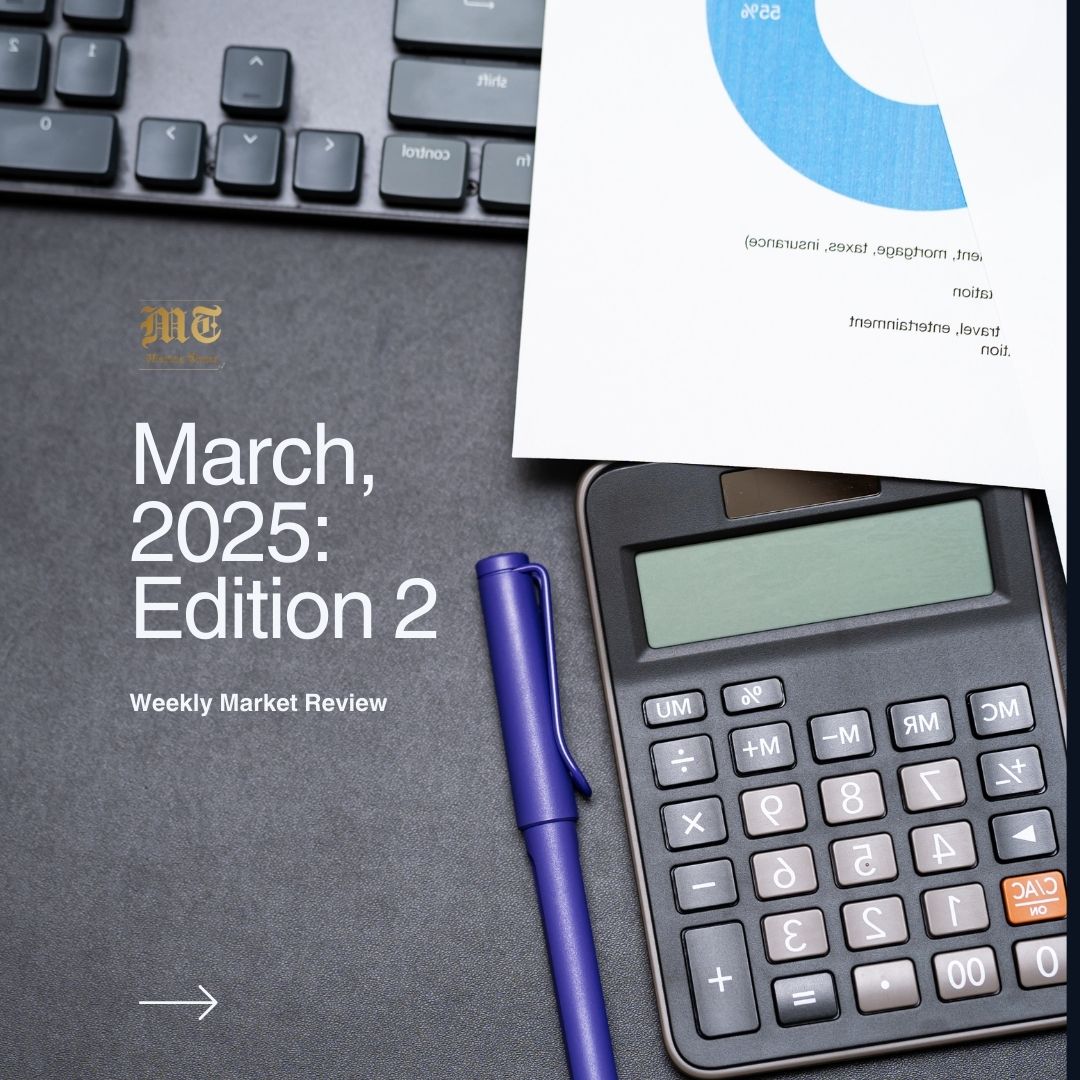

The increase in Nigeria’s FX reserves (surpassing $40 billion and nearly reaching $41 billion) was recorded as a significant milestone for the country given the recent economic headwinds. It was celebrated across the financial sector as an indicator of financial resilience. Many stakeholders have noted the recent dip in FX reserves to around $38 billion, concerned about the country’s ability to maintain external stability, especially considering its reliance on imports and external debt servicing. In tandem with this concern, the $/₦ closed at ₦1,542 and ₦1,575 in the official and unofficial markets, respectively.
Unlike most recent weeks, the financial system marked a notable liquidity surplus as a result of statutory inflows, coupon payments and security maturities. The shift to a liquidity deficit on Friday highlighted the dynamic nature of market conditions and the CBN’s role in managing those fluctuations, primarily by conducting an OMO auction the day before.
In the week under review, the Naira fluctuated between a high of $/₦1,615.00 on Friday and a low of $/₦1,490.00 on Tuesday, closing at $/₦1,542.00 on Friday. The money market sustained a liquidity deficit over ₦1 trillion. In line with this, short-term borrowing rates saw a slight uptick, with the O/N rate rising to 27.67%, and OPR to 27.08%, up from the previous week’s 27.33% and 26.75%, respectively.
The Foreign Exchange (FX) market is a vital component of Nigeria’s economy, playing a central role in facilitating international trade, investment, and debt servicing. The FX market determines the value of the Naira relative to other currencies, thereby impacting inflation, purchasing power, and economic stability. In recent months, there has been a gradual dip in FX reserves, from $40.9 billion on January 7, 2025, to $38.3 billion by March 6, 2025, attracting significant attention.
In the views of many analysts, a drop in FX reserves is something Nigeria cannot entertain at this juncture going by the gains in recent months. This movement in the FX reserves has raised concerns relating to the economic outlook, foreign exchange liquidity, and inflationary pressures. The significant dip in the reserves has far-reaching implications for Nigeria’s broader economy. The most immediate and visible potential impact is on the value of the Naira. As the Naira depreciates against major foreign currencies, the cost of imports increase, leading to higher prices for goods and services that rely on foreign exchange, thereby resulting in imported inflation and exacerbating Nigeria’s inflationary pressures.
A weakened Naira puts pressure on foreign debt servicing. Nigeria, like many countries, has significant foreign-denominated debt. As the Naira depreciates, the cost of servicing such debt rises, placing additional strain on the government’s finances. Such strain could increase the burden on Nigeria’s fiscal policies, forcing the government to allocate more resources to debt repayment, potentially at the expense of other critical areas such as infrastructure and social welfare.
Going forward, we anticipate sustained monetary tightening as a consequence of the sudden decline in FX reserves. The movement in reserves has raised questions about what significant payments could be driving this depletion. Many have adduced the drop to heavy spending to support the Naira. Where the currency interventions are not sustained, we may see increased pressure on the currency, potentially leading to further devaluation. A sustained decline in reserves would not only weaken investor confidence, but could also accelerate inflationary trends, further complicating Nigeria’s economic recovery efforts. We are hopeful that beyond successes with Foreign Portfolio Investor (FPI) inflows, we will soon be able to note some tangible Foreign Direct Investor (FDI) inflows to boost the economy on a sustainable basis.
The last two T-Bill Primary auctions reveal notable differences in investor demand and the potential implications for Nigeria’s fixed-income market.
The 91-day bills exhibited stable demand across both auctions, indicating continued interest by short-term investors in liquidity instruments. On the other hand, the 182-day bills saw a notable increase in demand, up by 20.4%, indicative of rising investor confidence in medium-term rates or expectations that interest rates will remain high. For the 364-day bills, subscription decreased from ₦2.30 trillion to ₦1.80 trillion, reflecting a decline of 21.6%, suggestive of the fact that investors could be cautious about locking their funds for a full year at the current yields, possibly anticipating a peak in Treasury Bill rates.
Looking at the stop rates, the 182-day and 364-day bills dropped by 25 basis points and 61 basis points, respectively. The 91-day rate, however, remained unchanged, indicating stable expectations for short-term rates.
The implications for the secondary market are significant. The increased allotment of the 91-day and 182-day bills point to a stronger demand for short-term placements by banks and institutional investors, which could result in higher liquidity at the short end of the secondary market, which in turn may lead to a slight decline in yields on short-term bills in the coming weeks. Additionally, the fall in stop rates for the 182-day and 364-day bills suggests that investors anticipate lower rates in the future, possibly due to lower inflation expectations or improved liquidity conditions. Where these expectations manifest, there could be a further decline in yields in the mid-to-long tenor segment of the secondary market.
AUCTION DATE | 05-03-2025 | 05-03-2025 | 05-03-2025 |
ALLOTMENT DATE | 06-03-2025 | 06-03-2025 | 06-03-2025 |
MATURITY DATE | 05-06-2025 | 04-09-2025 | 05-03-2026 |
TENOR | 91-DAY | 182-DAY | 364-DAY |
OFFER (₦) | 70,000,000,000 | 80,000,000,000 | 500,000,000,000 |
SUBSCRIPTION (₦) | 62,569,412,000 | 60,045,184,000 | 1,800,171,557,000 |
ALLOTMENT (₦) | 61,517,749,000 | 50,945,547,000 | 717,974,322,000 |
STOP RATES (%) | 17.0000 | 17.7500 | 17.8200 |
PREVIOUS STOP RATES (%) | 17.0000 | 18.0000 | 18.4300 |
At the end of the NTBs and OMO auctions last week, a reduction in the stop rates of both instruments was observed. For the 362-day OMO paper, the stop rate closed at 19.45%, with a total of N951.20 billion sold. This marked a reduction from the previous rate of 21.45%, indicating a significant decrease in the interest rate offered on these instruments. Similarly, the 355-day OMO paper closed at 19.19%, with a total of ₦725.70 billion sold, down from its previous rate of 21.32%, demonstrative of a notable drop in the yield on both the 362-day and 355-day bills, reflecting a shift in market dynamics.
TENOR | AUCTION DATE | OFFER (₦’ B) | BIDS (₦’ B) | RANGE OF BIDS (%) | STOP RATES (%) | PREVIOUS STOP RATES (%) | TOTAL SALE (₦’ B) |
355-DAY | 06-03-2025 | 300.00 | 760.70 | 18.8000-20.6400 | 19.1900 | 21.3249 | 725.70 |
362-DAY | 06-03-2025 | 300.00 | 1,116.65 | 18.8800-20.1800 | 19.4500 | 21.4500 | 951.20 |
The reduction in stop rates suggests that investor demand for short-term government debt instruments has increased, possibly due to liquidity improvements or market sentiment shifts. One of the primary drivers behind the lower stop rates is believed to be the surplus of liquidity. With more liquidity in circulation, the CBN and DMO can afford to lower the interest rates at which they issue these instruments.
It is also possible that the CBN could be signalling its intent to keep borrowing costs low and maintain an accommodative policy to stimulate economic growth. Further, lower stop rates could reflect efforts to reduce inflationary pressures and promote financial market stability.
In the weeks ahead, the direction of interest rates will be influenced by DMO’s borrowing disposition, which will be dependent on DMO’s interpretation of global risk-off tendencies (caused by tariffs sparked by the United States) as well as its preparedness to redeem the March 2025 maturity as well as coupon payments due among other obligations.
Although the current stance is reflective of concerted efforts to manage debt sustainability and substitute some debt with improved revenue, it is very likely that the DMO might capitalize on the significantly lower cost of borrowing to frontload issuance instantaneously, so as to hedge against any fundamental spike or reversal in yields that may lie ahead. It is also possible that the government might find it more prudent to limit debt issuance, as this could result in lower borrowing costs in the near term. The danger with this approach might be significant exposure to higher yields in tandem with global trends. We expect proactive OMO issuance by the CBN to curb excess liquidity as inflows hit the system.
Oil prices are expected to breach the 1 year low albeit with a swift reversal as Middle East and Russia-Ukraine developments continue to drive volatility. Cryptocurrency markets appear to be adversely affected by the disappointment at the first White House Crypto Summit which has been described by many as ‘a step forward, but not enough.’ The markets had priced in potential purchases to capitalize the US Cryptocurrency Reserve, only to be faced with the announcement that the reserve would be capitalized with confiscated assets already in the government’s custody. The fact that the establishment of the reserve will not drive any rally has been adjudged as negative by many analysts. Bitcoin is expected to record a new high soon as its gap with Ethereum narrows inevitably.